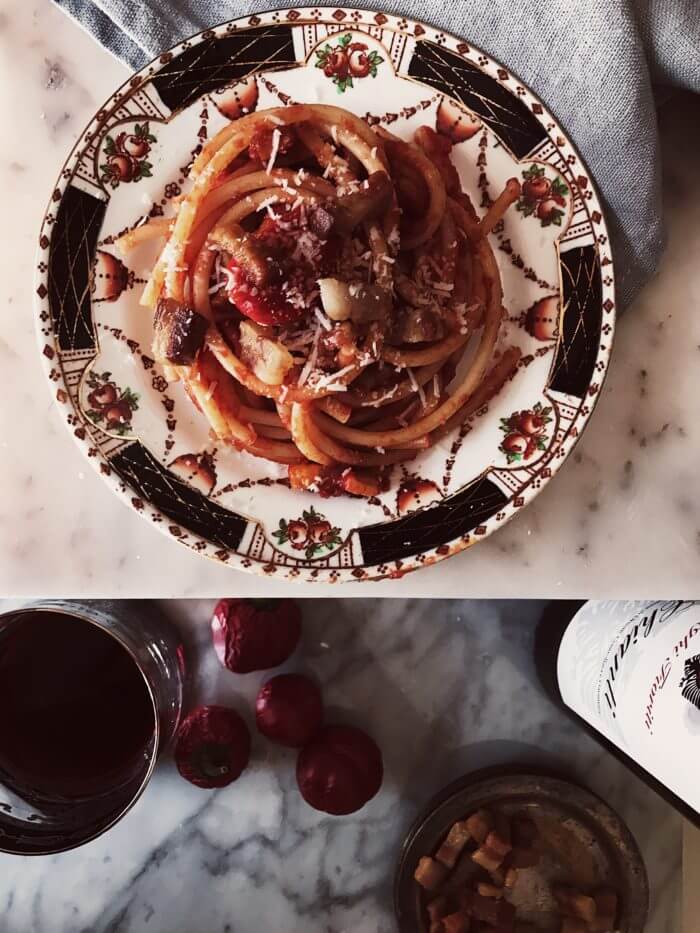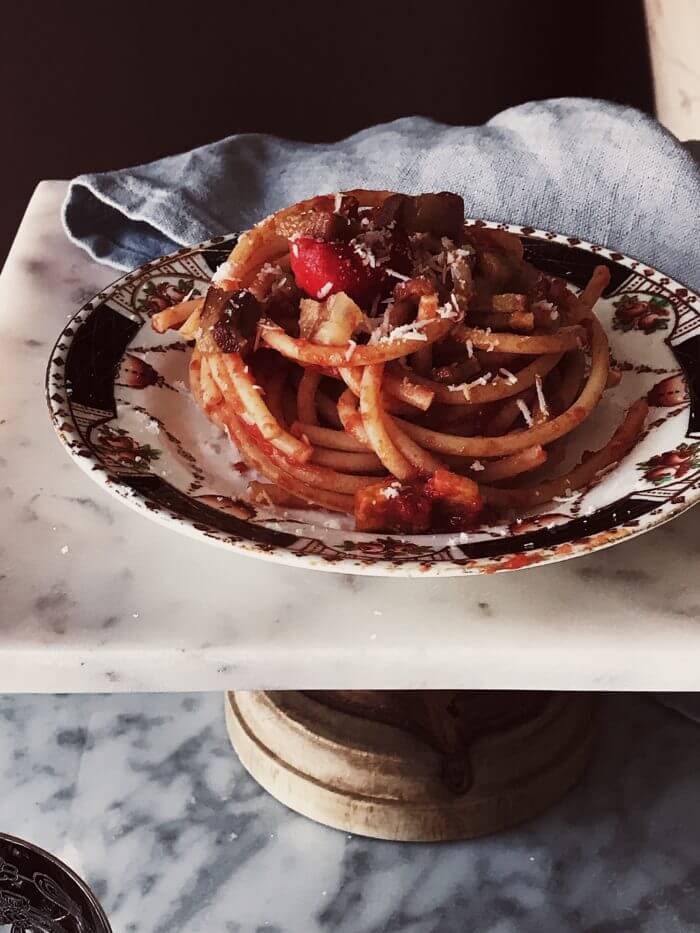The authentic Amatriciana recipe is a tasty guanciale and tomato sauce used to season bucatini (or spaghetti, or rigatoni).
Make an amatriciana sauce when you want an easy but delicious big bowl of pasta.
WHAT IS AMATRICIANA
The authentic Roman amatriciana recipe is a pasta dish made with local ingredients:
- guanciale: cured pork jowl – slightly different from pancetta;
- pecorino from Amatrice, which is a bit more delicate than pecorino romano, but don’t get paranoid: no one I know here in Italy really cares and can distinguish one from the other;
- and pasta, which varies: you can make bucatini, spaghetti, vermicelli, or rigatoni all’amatriciana.
There’s also a Roman-Jewish version of the amatriciana recipe. It is made with olive oil instead of pecorino and dried beef instead of guanciale.
The amatriciana sauce has uncertain origins, although we are talking of a few miles distance between a place and the other… It might be a recipe from Rome or Amatrice (a tiny town in Lazio, about 130 km from the capital).
We know for sure that both Romans and their neighbors eat bucatini all’amatriciana since the ‘800. Back in the day, just like nowadays, many people from the countryside worked and/or lived in Rome: the city was a big melting pot of people, traditions, ingredients, and recipes.
The people from Amatrice, a small town near Rieti, brought to the capital the gricia, the easiest pasta recipe ever: sautéed guanciale and pecorino cheese (try the gricia polenta: here’s the recipe).
When tomatoes were introduced to Italy, Romans decided to add them to the gricia, and make what we now call the Amatriciana pasta!
Back to the question: did it happen in Rome, or in Amatrice? If I were to guess, I would say Rome: I think tomatoes culinary uses arose there and in other big cities way before the small towns. Still, there must have been someone from Amatrice involved, why would they call it bucatini all’amatriciana if not?
A LITTLE PIECE OF ROME IN YOUR INBOX
I write a weekly newsletter about everything Rome – and Italy as I travel a bit. It’s called Italian Colors. Want to join the Italophiles’ clan?
HOW TO MAKE THE AUTHENTIC AND THE MODERN AMATRICIANA
The traditional amatriciana recipe doesn’t include wine nor vinegar, so you can skip them, but do me a favor and try it both ways. To me, grown up in a tad more modern kitchen, they’re mandatory.
Be careful not to burn guanciale: you want it crunchy. But you don’t want it mushy either, so keep an eye on the pan and be ready to turn off the heat a second before burning.
As always, look for the best ingredients you can find. The recipe is quite easy, and the simpler the dish, the better the ingredients must be!

authentic Amatriciana pasta
Ingredients
- 5.5-7 oz bucatini pasta 160-200 gr
- 1.7 oz guanciale 50 gr
- 1 chili
- 8.8 oz fresh tomatoes or a little more of canned tomatoes (pelati) 250 gr
- 1/4 glass white wine and vinegar mixed in equal parts
- 1.7 oz pecorino cheese 50 gr
- salt
- pepper
Instructions
-
Cut guanciale into strips and grate the pecorino cheese.
-
If you are using fresh tomatoes, bring a medium pot of water to a boil, add tomatoes and boil them less than a minute. Drain them and peel them (peel will come away easily at this point).
-
Heat a teaspoon of olive oil in a large skillet, add the chili and the guanciale.
-
Brown guanciale until crunchy. Add wine and vinegar, and cook, low heat, until alcohol evaporates (alcohol smell is gone).
-
Remove chili and a few tablespoons of guanciale. Discard the chili and set the guanciale aside.
-
Finally, add tomatoes and cook 10 minutes (add a few tablespoons of water if necessary).
-
Cook pasta al dente, drain it and pour it into the skillet, add 3/4 of the pecorino and sauté a minute or so.
-
Serve pasta hot, sprinkled with pecorino and the guanciale you kept aside.
Enjoy your Amatriciana pasta!
Claudia


